Sun allergy
definition
A sun allergy is usually understood to be a skin reaction caused by excessive exposure to the sun (UV radiation), which can take different forms and requires different treatments.

causes
The term sun allergy includes many symptoms and reactions of the body to light, UV and heat radiation. One of the most common skin rashes caused by the sun is so-called polymorphic light dermatosis, which can best be ascribed to the umbrella term sun allergy. It is also known as sun eczema and is more common in women than men. Adolescents and young adults are particularly affected.
There are many theories about the exact mechanism by which a sun allergy develops. However, this has not yet been precisely proven. The main trigger is suspected to be sunlight, which irradiates the unprotected surface of the skin for several hours. It is then assumed that there is a release of endogenous substances in the body, the exact origin of which is not yet known. These substances then stimulate the body's immune system. The immune system then produces IgE-type proteins that bind these messenger substances. The reason is that these endogenous substances are initially recognized as foreign and therefore the immune reaction starts. As soon as the body's own substances are bound by IgE, mast cells dock on the complex and, among other things, for the release of histamine. This then triggers the symptoms typical of allergies.
Histamine leads to a constriction of the bronchi (rather insignificant in the case of sun allergies) and to an expansion of the blood vessels and a resulting increased influx of blood. This ultimately leads to the familiar reddening of the skin. Furthermore, there are also forms of sun allergy that only arise from the combination of sunlight and certain medications or foods that were ingested at the time of exposure to the sun. A substance that is often mentioned in this context is St. John's wort, which is suspected of causing unpleasant skin reactions when exposed to the sun if it is taken for a long time. Skin reactions caused by certain substances in connection with sunlight are also known as phototoxic reactions. The mechanism of formation is complicated and is based on the emission of various chemical substances and intermediate products.
A rare special form of light and sun allergy is the so-called xeroderma pigmentosis, in which blisters can form on the skin even with the slightest amount of sun and light exposure. The affected patients usually have to spend their entire life in darkened rooms and avoid sunlight entirely.
Can you get a sun allergy in the tanning salon?
This is entirely possible, even if the composition of the radiation in the tanning salon differs from normal sunlight. The radiation contains more UV-A and less UV-B radiation, but both types of radiation can trigger a sun allergy. One reads again and again that a prophylactic visit to the solarium can prevent a sun allergy. However, this is only partially true. The point of this tip is that the body slowly gets used to UV radiation. Whether this happens in the solarium or in the spring sun is ultimately irrelevant. A sun allergy can be caused by both the sun and the radiation in the solarium. It is therefore important to increase the dose slowly in order to prevent the occurrence of a sun allergy.
Symptoms
Usually a short time after prolonged exposure to the sun on unprotected skin, there is initially symptom-free reddening. This initially goes unnoticed and is often mistaken for the onset of sunburn. In contrast to sunburn, however, with sun allergies in the further course of the process, pustules form, which become visible in the area of the reddened skin area.
Usually parallel to this, the patients complain of an excruciating itching that increases in intensity. Manipulation in the form of scratching the relevant areas of the skin worsens the situation and also leads to the skin opening and sore in the scratched areas. In the case of severe sun allergies, there may even be small blisters that are increasingly filled with fluid and increase in size.
Affected body regions are usually those areas of the body that have come into direct contact with the sun. As a rule, the areas of skin in the face area, forehead, cheeks, but also arms, legs and back can be severely affected during sunbathing. The otherwise typical allergic symptoms, such as tears and burning eyes, runny nose and scratchy throat, do not usually occur with a sun allergy.
As a rule, the symptoms only occur locally in the area of the exposed skin. The duration of the complaints is usually only as long as the skin is exposed to the sun. If the skin is protected with a sun protection cream or if the skin is covered with an item of clothing, the symptoms usually disappear quite quickly. At first the itching subsides, then the redness and pustules disappear. It is usually the case that in patients who have already had a light allergic reaction, the symptoms always proceed in the same way as soon as the patient comes into contact with sunlight. Overall, the symptoms of a sun allergy vary greatly from person to person, i.e. a sun allergy can express itself through other symptoms for everyone. In most affected patients, however, the reddening and itching of the skin are a large part of the symptom complex.
In some cases, there may also be a sun allergy when sun rays hit salt. In the case of patients swimming in sea water, it can happen that their skin begins to itch when the skin wetted with salt water comes into contact with sunlight. After washing the salt off the skin with fresh water, the symptoms mostly disappear.
What does a sun rash look like?
The term sun allergy does not exist in the medical sense. A sun allergy can describe various diseases, but mostly what is meant is the so-called polymorphic light dermatosis. However, this is probably not an allergy in the traditional sense. The skin rash that occurs with such a sun allergy can look very different. Spotty redness, pimples, nodules (papules), or blisters may develop. The symptoms usually only appear a few hours after exposure to the sun. Only those areas of the skin that have been exposed to the sun, i.e. not covered by clothing, are affected. Therefore, areas such as the neck and décolleté as well as arms, backs of the hands, legs and face are particularly affected. Usually it is an uncomfortably itchy rash.
More information can be found here: Rash from the sun
Sun allergy pimples
The type of rash that can occur with a sun allergy varies widely. Spotty redness, blistering, nodule formation, but also the formation of numerous small pimples can occur. The rash occurs only in the sun-exposed area.
Swelling of the face
Redness and slight swelling in the facial area can occur with a sun allergy. However, isolated swelling of the mouth or tongue, for example, indicates a different type of allergy. Such swellings can occur, for example, after an insect bite with a known insect venom allergy or with food allergies such as nut allergy. If the swelling of the mouth or tongue increases, a doctor should be consulted immediately. There is a risk that the airways will also swell, thus obstructing breathing.
You might also be interested in this topic: Insect bite first aid and emergency measures
Sun allergy on the eyelid
A sun allergy can manifest itself on all parts of the body that are exposed to the sun unprotected. It can also appear on the face. A sun allergy that occurs in isolation on the eyelid is, however, rather atypical. Maybe there is another disease behind it. A visit to the dermatologist can clarify this.
therapy
After a possible sun allergy has been diagnosed, long sunbathing and long exposure times should first be restricted. Furthermore, the skin should be covered when it comes into contact with the sun and protected with a high factor sunscreen. Furthermore, the dangerous midday sun should be avoided completely. Especially in patients who have to take medication that can cause light reactions when exposed to sunlight, exposure to the sun should be avoided or the medication should be changed if possible.
It should also be checked again with which skin creams the skin is being treated. If there is already a sun allergy with corresponding skin reactions, you should get out of the sun immediately. Any salt water deposits on the skin should be washed off with fresh water and the skin should be kept cool. You can also try to minimize the discomfort and itching by applying special cortisone and fenistile creams. Calcium supplements seem to have a positive influence on existing sun and light allergies and should be taken in the form of effervescent tablets.
Read more on this topic at: This is how you can prevent a sun allergy
Sun allergy medication
So-called antihistamines are used as classic drugs against allergies. These drugs, which reduce the effect of the messenger substance histamine in the body, can also have a soothing effect if you are allergic to the sun. They work against both the rash and the itching.Since it is still not clear whether the sun allergy is an actual allergy, the effect of antihistamines is not always sufficient. An attempt at therapy can, however, be useful. More important, however, is primary prevention using sun creams with a high sun protection factor or protecting the skin through appropriate clothing and avoiding the strong midday sun. In the acute stage, cortisone creams can also be used to relieve very severe rashes. The treating dermatologist should be consulted about this.
Home remedies for a sun allergy
In principle, it makes sense to prevent sun allergies in advance so that they do not occur in the first place. However, if a sun allergy rash has already helped, various home remedies can provide relief from symptoms such as itching, burning, tight skin and a feeling of dryness. The application of milk products low-fat quark or yoghurt on the affected skin areas leads to a gentle cooling of the skin. The quark mass can be covered with a dry cloth and removed again when it has dried on.
A mixture of apple cider vinegar is said to work wonders against the itching. To do this, 2 teaspoons of apple cider vinegar can be mixed with ¼ liter of water. The resulting solution can then be gently rubbed into the skin using a cloth. Due to their high water content, cucumbers also have a cooling and itch-relieving effect. They can be given directly as slices or mashed onto the affected skin areas. Healing earth is also said to have a soothing effect on symptoms of sun allergy. For this purpose, it should be mixed into a paste, which can then be applied to the affected areas. When it has dried, it can be removed with a damp cloth. Aloe Vera is also used as a remedy for a wide variety of skin irritations. Aloe vera can be bought ready-mixed in various forms in drugstores or pharmacies. Example ice as a gel that can be applied directly to the skin. In addition to the home remedies mentioned, applying vitamin E oil can also relieve the skin symptoms. Placing a damp cloth without any additional additives can also bring relief. Above all, it is important to avoid the sun in the acute phase of the rash or to wear appropriate clothing that protects the skin.
You might also be interested in this article: Home remedies for a rash
homeopathy
There are various homeopathic remedies that are said to provide relief from skin complaints, including those that occur as part of a sun allergy. This includes, for example, Hypericum perforatum (St. John's wort). However, it should be noted that the regular intake of St. John's wort can have a negative effect, as it can often lead to an increased sensitivity of the skin to light (photosensitivity). Sunbathing should therefore be avoided when taking St. John's wort regularly. It is not clear why exactly St. John's wort triggers increased light sensitivity, but at the same time has a positive effect on skin rashes in the context of a sun allergy. The homeopathic remedy Histaminum hydrochloricum is also said to relieve symptoms of a rash, as is sodium muriaticum. Furthermore, Apis, Urtica urens and Rhus toxicodendron are said to have a positive effect on sun allergies.
Calcium for sun allergies
Calcium had a reputation for preventing or significantly reducing allergies. However, there are no scientifically proven results on this. So there is no evidence that calcium is effective as a remedy for an allergy. There are isolated indications that calcium tablets taken regularly in good time before the first sunny days with increased UV radiation can alleviate the skin reactions that occur in the case of a sun allergy. It should be emphasized here, however, that it is still not clear whether the sun allergy is actually an allergic reaction in the true sense. Overall, there is no reliable evidence that the intake of calcium has a positive effect on a sun allergy. If the attempt to take calcium is to be made to alleviate a sun allergy, calcium intake must be started a few weeks before the first sunbathing.
Vitamin D for sun allergies
Similar to calcium, various claims are circulating that a lack of vitamin D can trigger sun allergies. Vitamin D is only sufficiently produced in the body if it is supplied with sufficient daylight. There is no scientific evidence to suggest that a lack of vitamin D is supposed to be the trigger for a sun allergy.
When do you need cortisone?
Cortisone can provide relief for pronounced skin symptoms with severe itching. It is used therapeutically for many different skin diseases. In the case of a sun allergy, the use of cortisone is often not necessary. If at all, local application in the form of a cortisone ointment is usually sufficient. The use of tablets containing cortisone is very rarely necessary in the case of a sun allergy.
What can you do about itching?
In the “Home Remedies” section, you will find a number of remedies that can relieve itching. For example, quark compresses or aloe vera. As a drug, antihistamines in tablet form can have a soothing effect on itching. Various creams, gels or ointments also alleviate the itching of skin rashes such as sun allergies. Examples include Fenistil gel, an antihistamine in gel form or ointments containing cortisone.
Which sun cream offers the best protection against sun allergies?
The most important thing for people who suffer from a sun allergy is always to use sunscreen before using the sun band. In the case of a known sun allergy, creams with the highest possible sun protection factor are recommended. So there are creams with a sun protection factor of at least 30, better 50. The sun cream should also offer protection against UV-A and UV-B rays. For safety's sake, sun allergy sufferers should also avoid ingredients such as emulsifiers and lipids. These are the triggers of the so-called Mallorca acne which are similar to a sun allergy and can be confused with it.
Prevent

With a few simple household tips you can prevent or even avoid a sun allergy.
The symptoms of a sun allergy, such as itching, redness and uncomfortable and even painful rashes in some cases, can become almost unbearable in midsummer. Therefore, it is advisable to stick to a few simple tips.
First and foremost is the protection of the skin through clothing. This prevents the bare skin from being exposed to direct, strong sunlight, especially when one is not yet used to solar radiation.
At the beginning of the warm season, clothing should consist of thin long-sleeved tops, long trousers and a hat. It is important to ensure that the face and hands are not directly exposed to the sun, but rather stay in the shade if necessary.
Wearing sandals and flip-flops is also tricky (without socks) in summer, as it is often forgotten that the feet are also exposed to a very large and permanent exposure to UV rays.
Sun allergy prevention usually begins in a shady environment by applying sunscreen to the skin to protect it from UV rays. Covered skin areas such as shoulders, neck and arms should also be thoroughly smeared with sunscreen.
It is important to ensure that the sunscreen is applied thinly and evenly and that it can be absorbed onto the skin before putting on your clothes.
It is important that the sunscreen has a sun protection factor of at least 30 or higher and has a filter for UV-A rays and UV-B rays.
Sunscreen is usually washed off with water or sweat. Therefore, after a water bath, the sunscreen should be reapplied to the dried skin.
In addition to a sunscreen, an antioxidant agent can be applied. This supports the skin's self-healing process.
The prevention of a sun allergy is very easy in many ways. For example, you should only expose yourself to the sun in stages and avoid long sunbathing.
Care should also be taken not to apply perfume, deodorant or other cosmetics, as these could cause painful reactions to the skin when exposed to sunlight and, in the worst case, lead to burns.
If there is a known sun allergy, it is possible to get your skin used to stronger solar radiation step by step through phototherapy by a dermatologist. This is and should be recommended before going on vacation to warm areas 4-6 weeks before departure respectively.
Duration of a sun allergy
A sun allergy usually occurs most strongly in the spring months when the sun is gaining strength and the skin is no longer used to so much sun. Often times you get used to it in the course of the summer. So the skin symptoms subside. Nonetheless, you shouldn't rely on getting used to it, but protect your skin from the radiation from the start with sunscreen. It is also advisable to slowly increase the sun exposure in order to get the skin used to the increasingly stronger sunlight. A sun allergy can reappear every year - even if the skin has got used to UV radiation at the end of summer.
Sun allergy in the child
Sun allergies can also manifest in children with various types of rashes. As with adults, red spots, blisters or nodules can form, which in most cases trigger significant itching. In children too, the rash with a sun allergy is limited to the areas of the body that have come into direct contact with the sun. Especially with children, it is important to ensure that they scratch the affected areas unchecked due to the itching, this can lead to skin injuries.
You can find out more about this at: Sun allergy in the child
diagnosis
An important part of the diagnosis is the health survey (anamnese), because it provides information about how long the symptoms have been present, whether they occurred for the first time and whether long sunbathing preceded it. It should also be asked whether the patients are taking medication and whether they already have another allergy. Lighter skin types are particularly often affected, as the skin is often more sensitive to sunlight.
You can find more information on this topic at: Rash from sun
However, tanned people can also suffer from a sun allergy. After the detailed patient interview, the doctor must inspect and examine the skin. Raised areas and pustules are felt to check their condition. A magnifying glass can be used for better inspection of the smallest skin changes. The diagnosis of a sun allergy is usually made through the combination of skin changes after exposure to the sun.
If there are any doubts, the doctor - in this case a specialist in dermatology - can carry out a so-called radiation test or light test. For this purpose, certain areas of the skin are irradiated with appropriate UV radiation for a few minutes. This process can also be repeated. If skin changes, redness, swelling or itching occur over the course of the following days, a light or sun allergy is as good as proven. If there are no skin changes, an allergic reaction of another cause must be assumed. In order to find and identify the triggering substance, appropriate sensitization tests (prick test) can be carried out in which the skin reactions after contact with certain substances are examined. There are different courses of sun and light allergy:
In a few cases, the allergic reactions to excessive sun exposure can be so high that anaphylactic reactions occur, which are associated with shortness of breath and life-threatening situations and must be treated accordingly. In order to rule out this, the above-mentioned light and radiation tests should only be carried out by a specialist in dermatology, who can then intervene immediately with medication if an anaphylactic shock develops. In some cases, radiation tests and skin prick tests give no clue as to the cause of the skin reaction. In this case, it may be useful to take a small skin biopsy and examine it in a pathology laboratory. Even if this may not be of any importance for the treatment, it is particularly helpful in making the diagnosis.
Summary
In the case of a sun allergy, skin changes characteristically occur after prolonged exposure to the sun. These consist of:
- Redness
- Scaling
- Blistering
- severe itching.
The reactions begin during or after exposure to the sun. They can be aggravated by certain medications or substances taken, such as St. John's wort.
A diagnosis is first made by interviewing the patient with regard to the duration and frequency, but medication taken and allergies that are already present should also be found out in the patient survey.
This is followed by the inspection of the skin, which can also be carried out using a small magnifying glass, the so-called dermatoscope. In cases of doubt, a sample irradiation can also be carried out in order to find out whether it is actually a light allergy. In some exceptional cases it may be necessary to take samples from the skin and examine them microbiologically accordingly.
The treatment consists of consistent sun protection and medication based on cortisone or fenistyle.








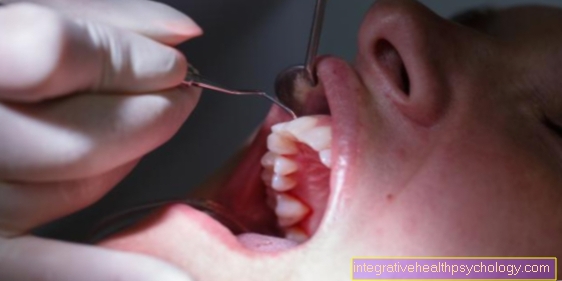

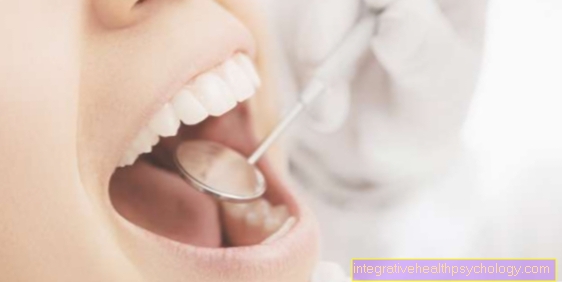
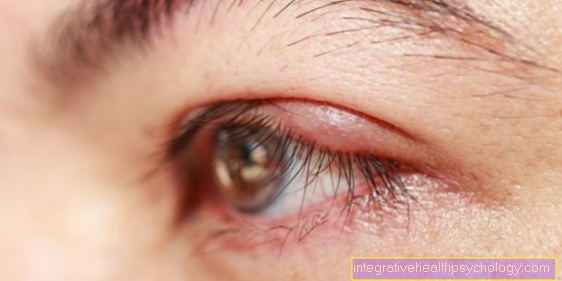

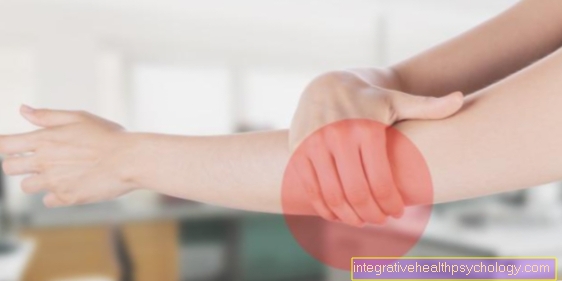



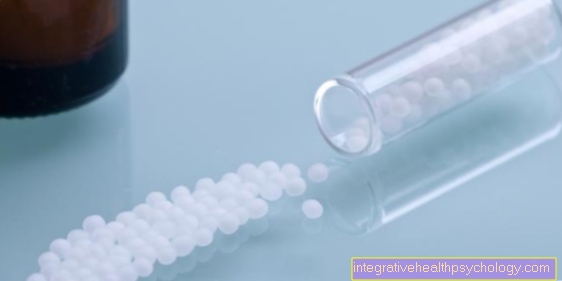











.jpg)